|
|
| |
|
 We do news right, not fast
We do news right, not fast
Note: This blog expresses only the opinions of the blog owner,
and does not represent the opinion of any organization or blog
that is associated with The Golden Rock.
|
|
October 30th, 2011
Tried to catch up, but only have energy to do one day:
The Yellow Sea (South Korea, 2010, Dir: Na Hong-Jin)
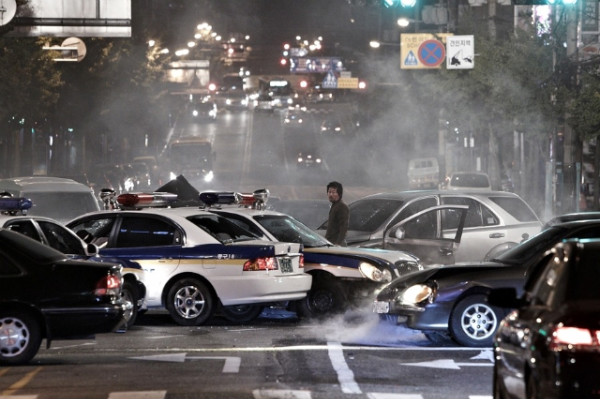
Director Na Hong-Jin’s much-criticized follow-up to THE CHASER starts out as a compelling crime thriller. Filled with tension and led by a great physical performance by Asian Film Awards Best Actor Ha Jung Woo, the first hour of THE YELLOW SEA is easily as good as THE CHASER. While the setup is fresh (Koreans living in China committing crimes in South Korea), it then turns into a typical man-on-the-run story that spirals into a crazy, violent free-for-all with plenty of stabbings, impaling, and running.
The more intense Na tries to make the film, the more it spirals out of control, with the extreme violence becoming as liberal as the use of fake shaky-cam. Soon, Na loses sight on his story just as he loses restraint, unleashing one last mean-spirited moment to show how much he hates all of his characters after 135 long minutes. One wonders how Na initially pitched his film at the HAF, and how much of his final product matched his vision.
Note: The version viewed is the 140-minute cut that Na took to Cannes (and reportedly his “director’s cut”, as opposed to the 156-minute theatrical cut).
Kaidan Horror Classics - The Nose (Japan, 2010, Dir: Lee Sang-Il)
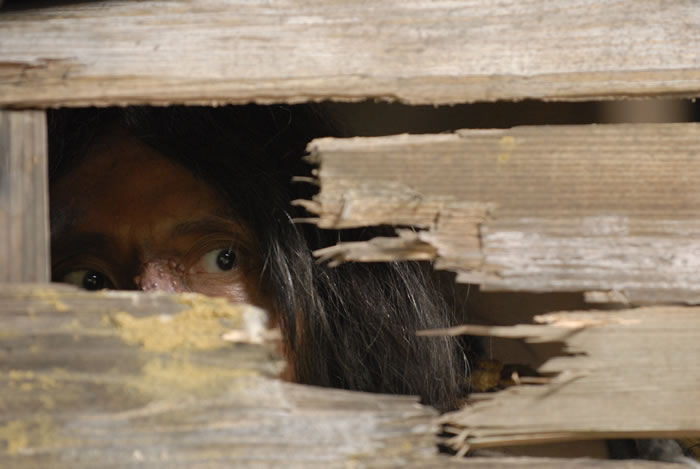
Four renowned Japanese directors each adapt a short story from a Japanese literary master (Yes, I can use this sentence because I wrote it for the festival catalog). HULA GIRL and VILLAIN director Lee Sang-Il chose Ryunosuke Akutagawa’s THE NOSE, about a priest with a disfigured nose who kills a child out of anger. The priest is essentiallly consumed by visions of the boy, whom he brings back from the dead to please the boy’s mother.
Lee’s direction is safe and even a little cold. Here, Lee fails to let us connecct to the characters, which is especially disappointing since that was the strength of his two previous award-winning films. In addition to the chilling score, which is essentially responsible for generating almost all the tension in the film, the most effective moment is the final moment of realization by the priest. Too bad the 30 minutes before that is a bit of a slog.
Kaidan Horror Classics - The Days After (Japan, 2010, Dir: Hirokazu Kore-eda)
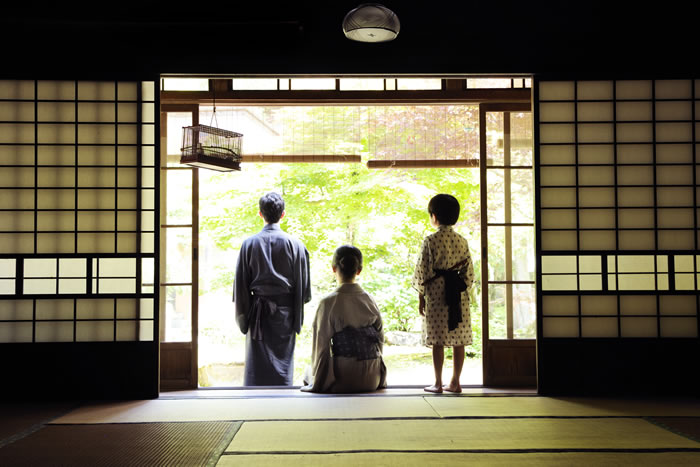
Kore-eda’s installment, adapting a story by Saisei Muro, has zero tension and zero horror. Instead, it’s a quiet story about pining and loss that’s sparsely written, but meticulously directed - almost like a kaidan film as imagined by Yasujiro Ozu. Familiar Kore-eda style framing can be seen throughout. It’s slow, but one can see that Kore-eda doesn’t let one single shot go to waste, as every cut reveals new information. It’s a brilliant exercise that should be used in film school classes to show how to tell a story visually, and the bittersweeet story is simple, but heartbreaking. One of the best things I’ve seen all year.
Out of energy today. Tomorrow: Indian education, prostitutes in the third world, another Giddens movie, some Taiwanese epic, and a movie about a raid
Posted in Uncategorized | No Comments »
October 29th, 2011
Back at the Hong Kong Asian Film Festival after two nights away, and because of some time miscalculation, the next two entries will serve up two days’ worth of reviews!
Smuggler (2011, Japan. Dir: Katsuhito Ishii)
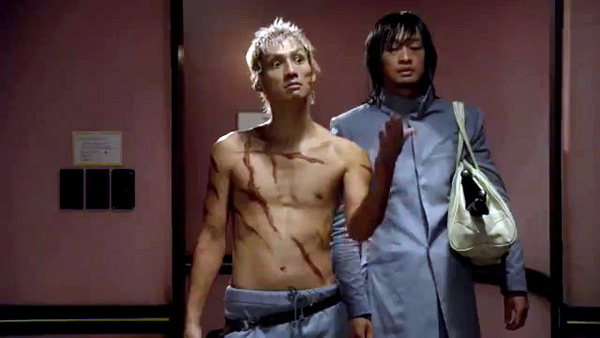
Don’t let his indie cred fool you: Katsuhito Ishii’s latest is brought to you by a committee of television stations and media companies that also fund big commercial films, AND it’s distributed by Warner Bros. Japan. It doesn’t play like a commercial film, but it is packed with reputable actors, special effects, and even a theme song by pop-rock band Superfly (tagged on like the committee demanded it).
While my own description for the film in the festival catalog sold it as a wild action-comedy, SMUGGLER is really a surreal crime drama with bits of inspired dry humor and action scenes. It was also far more violent than I had expected, with lots of blood, broken bones, and a good bit of torture porn (though the details are off-screen likely to avoid censorship) just to make it that much more unpleasant.
Adapting a manga series, the film version also seem to skip the second act of the story, going from a basic setup straight to the climax. I can’t say that SMUGGLER was a completely enjoyable ride, but a game cast of over-the-top characters (especially Masanobu Ando as a Chinese-speaking assassin) and the Ishii brand of surreal humor meant that I didn’t regret watching the film.
Jump Ashin (2011, Taiwan, Dir: Lin Yu-Hsien)
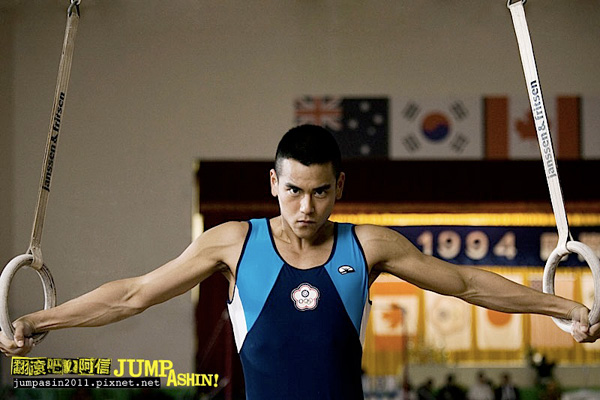
Lin Yu-Hsien, whose breakthrough film was JUMP BOYS, a documentary that featured his gymnast older brother, dramatizes that life story in this uncomfortable mix of underdog sports story and a coming-of-age gangster story. Eddie Peng gives an excellent physical performance as the titular character, going through an intense physical training regiment to play the gymnast-turn-gangster-turn-gymnast. Equally good is Lawrence Ko as Ashin’s best friend Pickle. Both are deservedly nominated for Golden Horse Awards this year.
Thanks to Lin’s assured direction, the film is an entertaining, seemingly matter-of-fact telling of a true story. However, the script takes a few implausible turns too many, especially towards the third act, making us wonder whether there’s an alternate ending that tells us everything in the third act is just a dream. While the gangster drama and the gymnast drama are fine as their own films, respectively, they don’t gel comfortably here, as one section undermines the efforts the actors put in the other section. While JUMP ASHIN is well-meaning and even sometimes engaging entertainment, it’s far from perfect.
Bloody Fight in Iron-Rock Valley (South Korea, 2011, Dir: Ji Ha Jean)
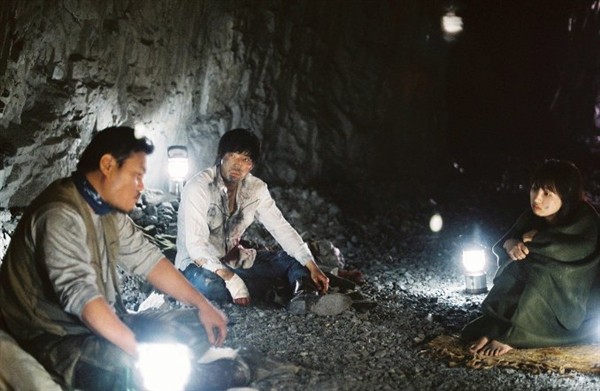
This low-budget indie revenge film brings together the plot of a Spaghetti Western and the violence aesthetics of a Korean revenge thriller. It copies the plot elements of the former just right - the hero with no name, the theme of violence in the name of development, there’s even a knife duel in the end. However, it’s lack of polish ultimately hurts the final product, as the film lacks the technical achievements that make westerns so powerful. ONCE UPON A TIME IN THE WEST isn’t powerful because of its story (because really, if it was just about the story, does it really need to be nearly three hours?); it’s because of how it tells its story.
The problem is that Ji is copying the story elements directly from films like ONCE UPON A TIME IN THE WEST and offers absolutely no surprise. Everything that happens in the story seem to be happening because the genre demands it, not because it’s where the story ought to be heading. Even good spoof films would take plots and twist it for comedic purposes. Here, it’s just rehashing.
That, along with lackluster post-production (sound mix!), less-than-great acting, and some dubious indie style direction send this genre exercise crashing down. It’s an interesting experiment, but one that the filmmakers obviously couldn’t afford to do properly. Just because you can copy a genre doesn’t mean you’ve made a good film. Obsessed film buffs only.
Next time: Korean stabbings, Japanese gothic tales, plus four additional movies. We’re killing ourselves over here.
Posted in Uncategorized | No Comments »
October 24th, 2011
Had tickets to two films at the Hong Kong Asian Film Festival today, but I decided to push back THE RAID to watch the 10th anniversary digital remastered version of Pang Ho-Cheung’s YOU SHOOT I SHOOT instead. So, this is the only film watched on Day 6:
Himizu (2011, Japan, Dir: Sion Sono)
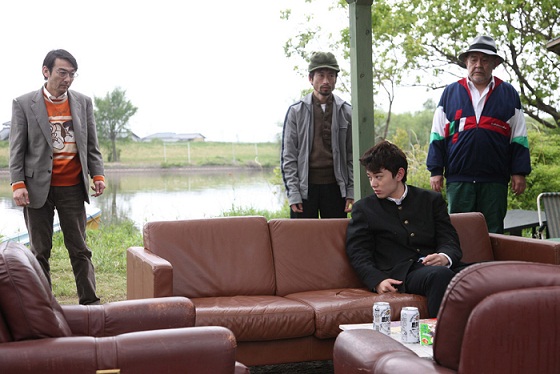
In the middle of the screening, I had to take a bathroom break and missed about 5 minutes of the film. However, I’m actually thankful that I had to take the break, because watching the film in one sitting is an extremely draining experience. From the extreme displays of emotions to the bombastic sound design, Sion Sono takes everything to the extreme in this drama about two tortured youths in post-earthquake Japan. At 129 minutes, HIMIZU is never boring, and it’s often compelling. However, it also feels like it’s about three hours long.
With that said, you’ll either be totally immersed into Sono’s storytelling style or feel completely alienated. I was the former, absorbed from the very first shot of the film, which shows lone figures wandering in the midst of the destruction caused by the earthquake and tsunami that destroyed a good part of northeastern Japan in March 2011. Many will be disturbed by the amount of smacking the lead actors take throughout the film, and you will have to be in tune with Sono’s very dark sense of humor to ride along with it as well. Those who do will be rewarded by this bleak, but engaging coming-of-age tale.
It’ll be interesting to see how Japanese audiences respond to the film come January, as it deals directly with how Japanese people are coming to grips (or not) with the devastating disasters. Some will be disgusted by how Sono portrays Japanese society, and some may admire him for the absurd, over-the-top social critique. Either way, it shows that just because Sion Sono is adapting existing work for the first time, he hasn’t lost his edge as a rebel working in the Japanese film industry. A brave piece of work, but I wouldn’t blame you if you have to wait for video.
Skipping two days due to a detour to the China Film Panorama and a night of rest. But next time: A tattooed assassin and a Taiwanese gymnast.
Posted in festivals, review, Japan | No Comments »
October 24th, 2011
I originally had three films scheduled for today: India’s THE KITE, plus the two I watched. However, an eye exam (plus the subsequent visit to the optical store) caused me to miss the film. So, day five featured only two films, both from Japan:
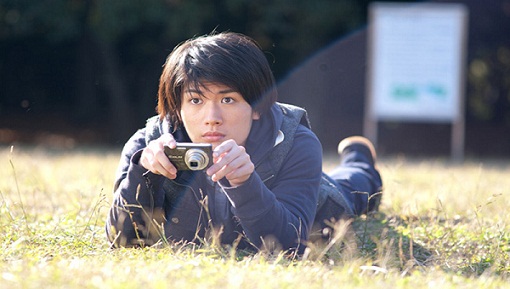
Tokyo Koen (2011, Japan, Dir: Shinji Aoyama)
I have three cities around the world that I consider home: Hong Kong, San Francisco, and Tokyo. As a result, I tend to be easier on films that can represent these three cities well. That may be why I found the latest Shinji Aoyama film to be more engaging that i had expected it to be. On the surface, the lighthearted drama is about the three women in the life of an aspiring photographer. However, in Aoyama’s hands, TOKYO KOEN breaks through simple Japanese indie aesthetics with its picturesque journey through Tokyo’s parks and an odd sense of humor that only Aoyama can pull off.
While Nana Eikura plays the impossibly cute, perky film buff (LIPSTICK reference!), it’s Manami Konishi that surprised me as the hero’s step-sister. Usually playing withdrawn, quiet characters, Konishi exudes a sexy, seductive vibe that I’d never seen before from her. The film’s too light to attract any attention for her performance, but TOKYO KOEN may be my favorite Konishi performance yet.
On a more personal note, the film has also inspired me to take a journey of my own on my next trip to Tokyo. While going around all of Tokyo’s parks may be a bit much, it would be nice to see parts of the city I’ve never been to. Aoyama’s version of Tokyo is one that overseas viewers rarely see - one with little sense of urbanization and technology (the hero insists on using an old film camera). Tokyo’s parks is as big a character as the four human characters in the film, and I would argue that it’s the most beautiful one.
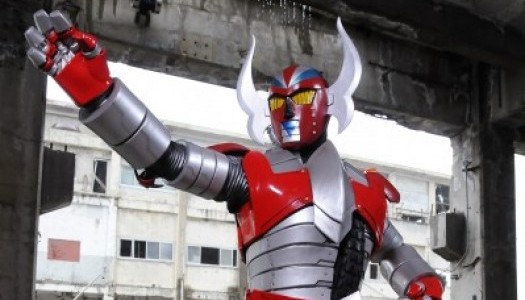
Karate Robo-Zaborgar (2011, Japan, Dir: Noboru Iguchi)
Nikkatsu’s Sushi Typhoon has mostly been specializing in exporting blood, guts, and projectiles shooting from human bodies from Japan to the world - which means they’ve pretty much been making films for foreigners. However, KARATE ROBO-ZABORGAR finally feels like a Sushi Typhoon film for the Japanese audience, even if it’s a very small amount that can appreciate modern throwbacks to cheesy 70’s superhero shows.
The best way I can describe KARATE ROBO-ZABORGAR is a low-budget version of YATTERMAN - a live-action fantasy superhero adaptation that both recreates and parodies its genre. If you look for video of the original ZABORGAR show (or just watch the credits), you’ll see how hard director Noboru Iguchi (MACHINE GIRL) worked to get the film right. However, when he gets to the second half of the film, which jumps 25 years to present day, into the portion of the story not based on the original show, Noboru struggles to keep the energy up as it starts to overstay its welcome.
Still, KARATE ROBO-ZABORGAR is great, irreverent fun at the movies, except when Noboru had to do his Sushi Typhoon duty by throwing in girls in bikinis, blood spraying, and projectiles shooting out of strange places. The rest of the film is so inspired as parody that I wish it left the Sushi Typhoon label so it wouldn’t have had to give any fan service. But I suppose the film wouldn’t have been made without Sushi Typhoon, so KARATE ROBO-ZABORGAR is what it is.
Tomorrow: Sion Sono looks at post-earthquake Japan.
Posted in festivals, review, Japan | No Comments »
October 22nd, 2011
I didn’t actually attend any screenings on night four of the 2011 Hong Kong Asian Film Festival. However, I did pop in my 2010 Fresh Wave DVD for a short film that did screen at the festival that night:
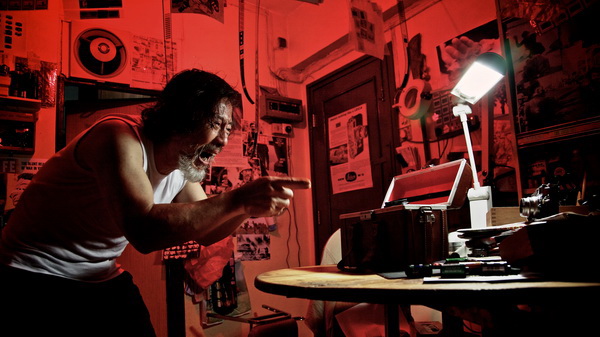
The Decisive Moment (2010, Hong Kong, Dir: Wong Wai Kit)
FULL DISCLOSURE: I was an assistant director on a film that competed alongside this film at the 2010 Fresh Wave Festival.
The winner of Best Cinematography at the open competition section of the 2010 Fresh Wave Film Festival (independent short films funded by the HK Art Development Council) has more than just good cinematography going for it. After opening with a shocker of a sequence, the mockumentary-style drama tells the story of a young news photographer who has to team up with a veteran photographer traumatized by a past event. Wong Wai-Kit’s script carries plenty on its plate, dealing with the bond between the old and the young, the old photographer’s guilt, and even a small course on journalism ethics. In fact, it has so much on in its 35-minute running time that the film felt like a digest of a better feature-length film. The bond isn’t as affecting as it should’ve been, and a deeper insight into commercial interest vs. professional ethics would’ve benefited the film greatly.
Nevertheless, what’s here is very impressive for a Hong Kong independent film. The cinematography award is well-earned thanks to the advent of DSLR, and it is a very compelling film for anyone with a remote interest in the media. The acting in the “documentary” sections isn’t natural enough to make it convincing, which means it might’ve been better if it was just chucked out, but the two leads are actually quite good.
The Fresh Wave Film Festival is an emerging organization of the Hong Kong film industry worth looking at. In a world where Hong Kong commercial filmmakers are constrained by Chinese censorship, Fresh Wave gives aspiring filmmakers in Hong Kong the chance to express themselves without fear of censorship by directly funding their films. Many of the young filmmakers at the festival even take the opportunity to explore social and political issues that are too sensitive or too uncommercial for mainstream cinema. Festival head Johnnie To has even reportedly recruited festival contestants to work at Milkyway. While the quality of the films are hit-and-miss, THE DECISIVE MOMENT (as well as Grand Prize winner/indie breakout 1+1) is definitely one worth checking out.
Also screening along with THE DECISIVE MOMENT in the same program is:

Devil Nail Clippers (2010, China, Dir: Jimmy Wan/Derek Tsang)
DEVIL NAIL CLIPPERS is actually the first film of Pang Ho-Cheung’s “4+1″ project, which involves four short films (produced by Pang) and one feature-length film. The four short films - invested by Samsung and Sina (watch for the shameless product placements!) - are available online for free, which is why I already saw the film earlier in the year. Like the print at the HKAFF, the internet version only has Chinese subtitles.
While the basic premise is based on an installment in Pang’s TRIVIAL MATTERS short story anthology, the short story simply makes up the opening scene of the film, about a girl (Zhou Xun) confessing to her boyfriend (Lawrence Chou) that she’s “nail clipper demon”, which means she only eats nail clippers (NOT nail clippings) to stay alive. What follows is a dry-as-sandpaper dark comedy with a devilish twist that kicks off second half of the 45-minute short film.
Since this is an internet-based short film, I assume that Pang and co. are able to go around stringent Mainland censorship (correct me if I’m wrong). While DEVIL NAIL CLIPPER doesn’t have much objectionable content, it is a surprisingly cynical little film that would not have made it through SARFT. Like Wan and Tsang’s LOVER’S DISCOURSE, DEVIL NAIL CLIPPER is not for everyone, but those who enjoy’s Pang’s sly sense of humor should find something rewarding here.
You can watch DEVIL NAIL CLIPPER (in two parts) -and other 4+1 Project films - here. DEVIL NAIL CLIPPERS already has 10 million views. Yes, it’s perfectly legal.
Coming up on day 5: A park in Tokyo, and a robot that does karate.
Posted in festivals, China, review, Hong Kong | No Comments »
October 22nd, 2011
This is the quiet beginning before HKAFF goes into full swing, so only one film once again today:
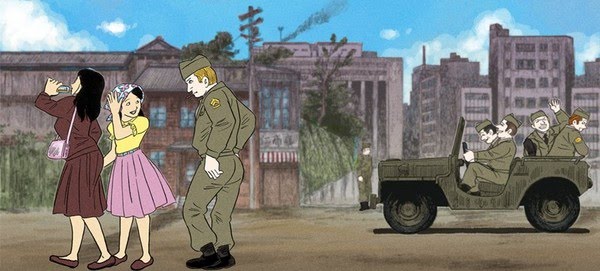
Tatsumi (Singapore, 2011, Dir: Eric Khoo)
Singaporean director Eric Khoo pays a sentimental tribute to Japanese comic artist Yoshihiro Tatsumi, who led the way for adult-oriented comics, or “gekiga”. In addition to adapting his autobiographical graphic novel DRIFTING LIFE, TATSUMI also adapts five of the artist’s short stories. Some of them - the twisted noir piece HELL and the darkly comedic JUST A MAN - are delightfully twisted works filled with haunting imagery. However, some jarring editing and a lack of real insight into Tatsumi’s storytelling style make this sentimental tribute just a tribute more than a real attempt to understand the artist.
TATSUMI is clearly made by a fan, an admirer who doesn’t dare deviate much from what he loves about his idol. I came out having a generally positive impression of Tatsumi’s works, but I’m not sure if the film compelled me to look for more of them. Without that real insight into Tatsumi’s world (his life story - as narrated by Tatsumi himself - is straightforward with just one moment of the surrealism one would see in his work), TATSUMI is a sometimes beautiful piece of work that some may find difficult to connect to emotionally.
Tomorrow: DECISIVE MOMENT, and bonus track: DEVIL NAIL CLIPPER
Posted in festivals, review | No Comments »
October 20th, 2011
Day 2 at the 2011 Hong Kong Asian Film Festival featured only one film:

Cut (2011, Japan, Dir: Amir Naderi)
With Japanese filmmakers like Shinji Aoyama and Kiyoshi Kurosawa attached, CUT fortunately doesn’t fall into the foreign filmmaker in Japan syndrome that sees directors misrepresenting Japan and its cultura. Instead, CUT sees Naderi flaunting his love for the art of cinema via an obsessed cinephile who spends his days screaming about the nature of “pure cinema” and holding rooftop screenings of classic films. Forced to take on the 12 million yen debt his yakuza brother left behind, the cinephile becomes a human punching bag for yakuza thugs for money with the help of a bar girl and an elder gang member.
There’s little doubt that those who aren’t arthouse film buffs will find CUT wildly self-indulgent. The abuse the man takes can be an allegory for the indignation passionate filmmakers take for the sake of their art, but even those that understand that metaphor will find it difficult to identify with Naderi’s manic cinema addiction. Essentially, this is the kind of film that an arrogant film school student might make given the resources Naderi has.
In addition to its artistic ambitions, CUT also suffers from a loose narrative that becomes redundant after the intriguing 45-minute setup. At 132 minutes, CUT doesn’t do enough with its central idea to earn the running time, making it a bit of a slog to sit through. It’s not a particularly violent film (lots of punches and lots of bruises, but very little blood), but seeing star Hidetoshi Nijishima getting punched repeatedly for an hour and a half can get a little uncomfortable to watch.
With that said, CUT is sometimes involving, and cinephiles (especially film school graduates) will identify with its obsession with its love of cinema. However, it still suffers from the problem that films about filmmakers suffer from: It assumes that the plight of a filmmaker is interesting even to those not interested in films.
It isn’t, and I’m a film school graduate.
Day 3: Tatsumi.
Posted in festivals, review, Japan | No Comments »
October 19th, 2011
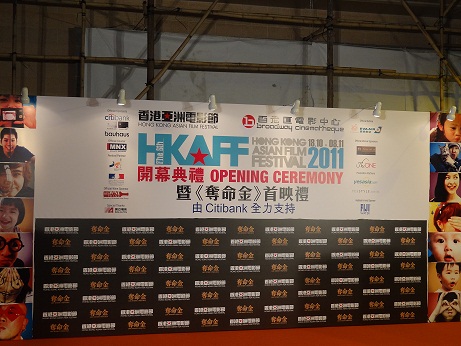
Autumn and Chinese pollution are in the air, which means it’s time for another edition of the Hong Kong Asian Film Festival! Asian cinema and assigned seating being my favorite things in the world, Broadway Cinematheque’s Hong Kong Asian Film Festival is the annual event I look forward to the most each year. This year, I’ve picked 29 films to take in theatrically over the three-week period, plus several others I will catch through other means. I will try to cover as many of them here as possible, and the best way to do that is through daily entries!
Films I’m looking forward to this year include the four-hour version of SEEDIQ BALE, the Chinese road film KORA, the Taiwan-shot/China-funded STARRY STARRY NIGHT, Hong Kong indie BIG BLUE LAKE, Korean actioner THE YELLOW SEA, and Korean animated film GREEN DAYS.
But first, I watched the opening film, Johnnie To’s LIFE WITHOUT PRINCIPLE. Many of my thoughts for the film have been covered in my Twitter and the East Screen/West Screen podcast, but I will cover them again here:
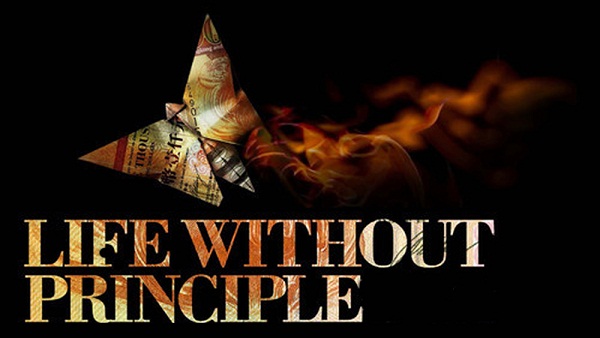
LIFE WITHOUT PRINCIPLE (2011, Hong Kong, Dir: Johnnie To)
LIFE WITHOUT PRINCIPLE doesn’t have a lesson, and it’s not a morality tale (unlike many social issue films tend to become). It’s Johnnie To’s observational piece about Hong Kongers’ desire to get rich quick and how that can affect their and others’ lives. Despite being shot on-and-off over the course of three years, To and his ace editing team manage to weave a well-structured ensemble piece of three interconnected stories featuring characters all driven by greed.
To flashes a mirror at his home audience, using elements inspired by stories ripped from the headlines to show what Hong Kong society has become. He literally equates the financial market to a casino, where higher risks not only means bigger wins, but also more devastating losses. Despite being To’s quietest and dryest film since ELECTION 2 (no human meat grinding here, either), it’s an absorbing drama that takes its time to draw you into its world. The payoff yields some surprising dark comedy (To’s brand of absurdity remains), and it leaves plenty of room for you to rethink how you perceive characters that initially appear to be heroes.
I’ve seen the film twice now, and while the surprises in the final third don’t play as well the second time, the first hour is still as involving on repeat viewings. It moves slowly, but To assures you that you’re in good hands. While it’s not the most cinematically satisfying Hong Kong film of the year (that still goes to WU XIA, in my opinion), the fact that Hong Kong finally now has a good film that’s really trying to speak to the Hong Kong people makes LIFE WITHOUT PRINCIPLE the best Hong Kong film of 2011 so far for me. What a great start to the festival.
Coming up on day 2: Amir Naderi’s CUT.
Posted in Uncategorized | No Comments »
October 7th, 2011
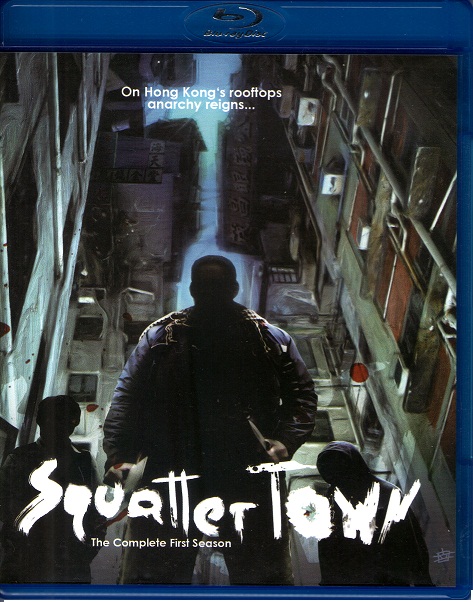
Thanks to Marco Sparmberg, I recently got my hands on the Blu-ray of SQUATTERTOWN, his independent web series.
What is SQUATTERTOWN, you ask. I’ll just let Marco do the talking:
Squattertown is a trans media production centering around a mini web series. Sole crowdfunded via 35 backers from 7 countries around the world Squattertown is an interactive web based project on a global scale. Created as first Dim Sum Western, this web series tells the grim story of “a dystopian parallel universe in which Hong Kong’s wealth gap has grown to the point where a vast underclass is forced to live in a parallel city that exists above the heads of the affluent.”
Why is SQUATTERTOWN important? 1) It’s one of the most ambitious ideas I’ve heard of for a Hong Kong indie. It actually tries to do something different with the Hong Kong cityscape on a indie budget (and it manages to pull it off) 2) It’s a successful example of crowdfunding, which involves relying on contributors from around the world to make up a budget for a film. It tests a filmmakers’ ability to pitch the project to the world, not just a boardroom of rich men.
The series is web-based (link at the end of the entry), and it can be viewed for free. But since I’m one of those contributors (LoveHKFilm is also credited in the Special Thanks section), Mr. Sparmberg was kind enough to give me the Blu-ray version of his film.
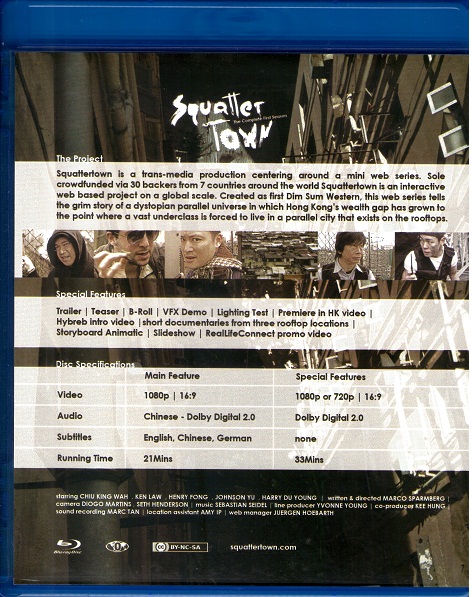
The disc includes not only the entire first season of the series, it also includes a surprising amount of featurettes, covering various stages of its production (including the world premiere!). Obviously, the blu-ray disc won’t be of demo quality, and it’s not readily available, so I won’t be going into the audio and video quality of the disc.
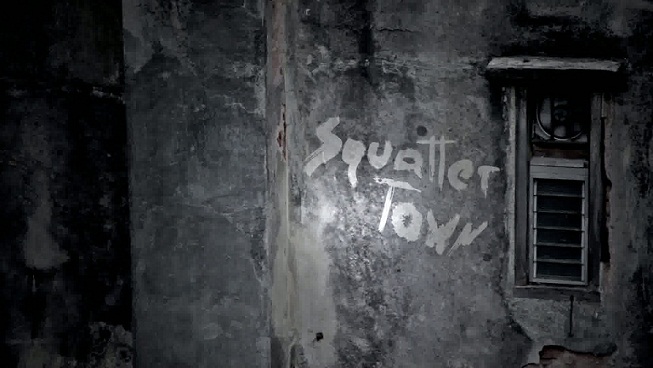
It doesn’t matter whether you understand the story of SQUATTERTOWN or not (and you’re more likely to not anyway). It’s all about experimenting with genres, specifically a mix of Hong Kong cinema and Spaghetti Westerns. Using a gritty Hong Kong cinema aesthetic (mainly a gray palette and lots of handheld camerawork), Sparmberg slowly brings two stories together into one (their connection isn’t even revealed until the third episode), but he doesn’t offer much clues nor clear answers about his characters or their motivations. You won’t understand SQUATTERTOWN, but it might not even really matter by the end.
Hong Kong independent cinema isn’t known for its ambitions, which is why it’s impressive to see visuals like these in the series:
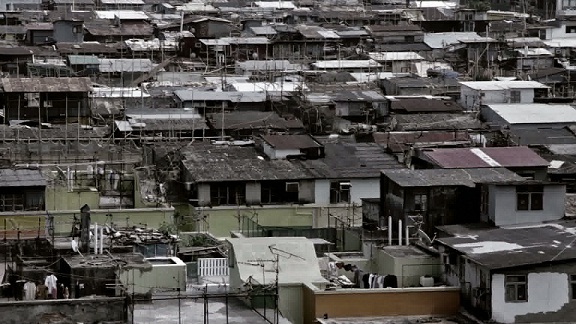
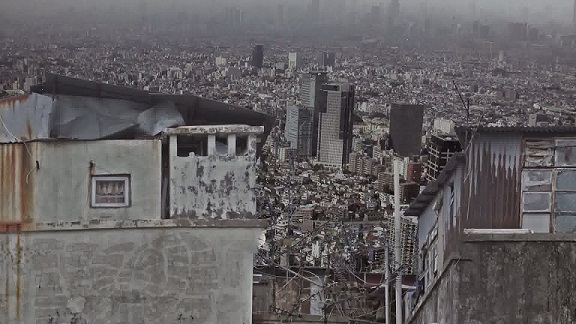
Yes, it looks better when the shot is moving
Mostly shot on location on Hong Kong’s rooftops, SQUATTERTOWN really does feel like it lives in its own world. Considering that many of these locations are being torn down by redevelopers, the series also serves as a record that these old buildings really did once exist, and you don’t have to wait for the future to find people living in these rooftop housing.
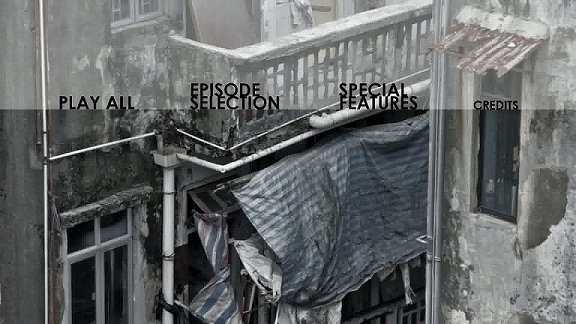

In addition to the four-episode series, the SQUATTERTOWN blu-ray also includes a whole lot of special features. Marco captured practically every stage of production, including the teaser he made to gather funding (trust me, it looks VERY different from the final product) and footage from each of the real rooftop he shot at. It’s pretty much a step-to-step guide that shows how he managed to put this thing together with himself and the hard work of a few others.
Where can you get the blu-ray, you ask? Well, you can’t, unless you contact Marco directly. However, you can check out the entire series (HD available) and these making ofs on the series’ Youtube channel or links to the series on other video sites on the official website.
Posted in Uncategorized | No Comments »
September 3rd, 2011
(Note: This entry was edited on September 4th to fix a link. Also added one small paragraph about SEEDIQ BALE and an additional line about Zhao Baohua and the rating system)
- In the entertainment industry, you should always watch what you say publicly, especially when it might offend the powers that be. Of course, when you become one of those people, you can say whatever the hell you want, as long as it doesn’t offend the people above you.
Feng Xiaogang is one of those people. China’s most commercially successful director and a Huayi Brothers shareholder, Feng Xiaogang has always been an outspoken man, and this time, he is taking on China’s State Administration of Radio, Film, and Television
(Note: The following report is sourced and translated from multiple articles, which you will be able to find at the bottom of the entry. Yes, you will have to read Chinese to know which is which)
Remember when I blogged before about how many people get a share of total box office gross in China? I wrote that it is split (never evenly) amongst cinemas, distributors, and investors. However, what I didn’t know was that the SARFT takes 5% from the theatrical gross of any film that is publicly exhibited in China, in addition to the 3.3% revenue tax. The 5%, which goes to a government film fund that aims to help build film screening infrastructure in rural areas, fund children’s films, and fund “Main Melody Films” (I’m gonna have to start a glossary for these terms soon).
At least that’s what they say the fund does. Anyway, Feng, who is a member of the Chinese People’s Political Consultative Conference, recently attended a conference on the Chinese cultural industry and spoke about problems in the Chinese film industry. One of the problems, he said, is the way the film fund makes money.
He used the example of Huayi Brothers. The box office revenue for their films in 2010 was 1.7 billion yuan. After taking away the cinema’s share, money spent on promotion, production, taxes and various fees, the company made a profit of 80 million yuan. On the other hand, the film fund collected 40 million yuan from Huayi, which is already half their profit. Huayi is one of the most profitable film companies in China, so imagine how much this 5% hurts the smaller companies.
To help production companies and investors find an easier way to profitability, Feng suggests that the government should be paying for the work of the film fund, and SARFT should abolish the 5% tax. Yes, he went there.
And he didn’t just stop there, either.
Feng then went on to criticize the SARFT’s censorship process. Essentially, what he says is that the censroship process has come under heavy scrutiny by the audience, to the point where “SARFT examines films, while the people examines SARFT”. He also points out that the pressure from SARFT’s censorship ends up on the filmmakers, as the suggestions for cuts have reached the point of becoming laughable. Also, the audiences ends up blaming the flaws caused by these censorship cuts on the filmmakers.
Feng said even his AFTERSHOCK, which underwent changes from censorship, was heavily criticized for things that were ordered to be there due to SARFT censorship. In such an environment, directors have all flocked to historical films in order to avoid censorship troubles. As a result, Feng noted that there has only been a few “game changer” films in the Chinese film industry. As a result, he requested that the SARFT examines the negative effects of film censorship.
And then came the responses.
A representative for the film fund defends its tax, saying that 1) The film fund is designed to improve the Chinese film industry, and 2) This is a practice that has been done around the world, including France and Korea. In fact, according to the rep, some countries take even more than 5%! In other words,we do what we’re supposed to do, and it’s OK for us to do it because foreigners do it, too!
Still, the most useful thing this spokesman said was the five main functions of the film fund: 1) To renovate old cinemas, 2) Assist in the construction of cinemas, 3) Install digital projection in cinemas across the country, 4) Screen films in rural areas, and 5) “prepare for new technology in cinemas”.
Meanwhile, industry people like Huayi’s head Wang Zhonglei and Starlight’s Song Guangchang are naturally for abolishing the tax. Meanwhile, others have included alternatives like waiving the tax for films that cost less than 10 million yuan, or waiving the tax for Chinese made films and collect only from imported films. Good luck making that latter one work for co-productions.
As for the censorship comment, the head of LeTV suggests being more lenient on cuts for mid-to-low-budget films to “encourage creativity and explore unique topics”. On the other hand, director Fei Xing (of THE MAN BEHIND THE COURTYARD HOUSE) recounted the four months he dealt with censorship and ended up hearing audience criticized him for awkward SARFT cuts. He suggests that the censors should skew younger and take part in more communication with filmmakers.
Film critic/scriptwriter/SARFT censor Zhao Baohua defended SARFT’s work (though he insisted he does not speak for SARFT, but only for himself), saying that films are only undergoing “bottom-line examination”, meaning that as long as the film’s content don’t violate any laws, it will pass. As for films with sensitive topics and violence, SARFT will give their “suggestions” as a responsibility to film fans and the Chinese film industry.
Zhao said that the media is currently demonizing SARFT and the censorship committee for their work, because the films SARFT has halted productions on are bad films anyway. “When a film deviates from mainstream societal values and the market, the fault should not go to the censorship process. Instead, they [the filmmakers] should examine what went wrong with the film,” said the censor. He also felt that China is not ready for a rating system because it would mean that deviant category III films filled with violence and sex would make its way into Chinese cinemas. He even compared category III films to opium, saying “How can opium enter the market? That is absolutely unacceptable.”
Of course, being the SARFT, that fund is not likely to go anywhere, and censorship will be just as heavy, even if there’s a rating system. The government is intent of maintaining its authority over people, and it’s not about to lose the film industry’s influence over people for petty things like artistic integrity. Then again, maybe I’m just pessimistic like that.
- In other news of directors speaking out, Gordon Chan recently expressed his own concerns about the Chinese film industry at a recent event for his latest film MURAL. Chan was asked whether his film is truly worth watching, or is it just another bad film trying to force its way into cinemas to cash in on the emerging industry. He admits that there are many films with a higher budget for promotion than production to hype the film to death, only to disappoint audiences in the end. This is why he vows not to play that kind of game for MURAL. Yes, it’s quite obvious that Chan never played that game, especially since the production budget for KING OF FIGHTERS couldn’t possibly go any lower.
Anyway, the rest of is promotional fodder, so we’ll just skip all that.
- The 150-minute international version of Wei Te-Sheng’s SEEDIQ BALE (referred to as a “Chinese language film” in most mainstream Mainland Chinese media, by the way, without any regional label, despite what some western media say) had its world premiere at the Venice Film Festival, and review has been fairly mixed. Two Chinese-language review pretty agree that while its budget is clearly on the screen, the film in its current form lacks something to earn its “epic” label. One review even call it a live-action attempt at AVATAR (though Wei began developing the project long before anyone knew what AVATAR was).
Meanwhile, reviews on Variety, Hollywood Reporter, and Film Business Asia are also mixed, pointing the film’s violent and bombastic nature.
So SEEDIQ BALE may not be very good, at least in the form of a 150-minute film. But how is the media in Taiwan, where the film may become a game changer for its commercial film industry, reacting to all of this?
The Liberty Times and Yahoo News are focusing on the positive, reporting that the film was well-received at the festival screening with a 10-minute standing ovation, and that the producer proclaimed the price for North American rights immediately went up after the screening. They also reported the full, 4.5 hour version has been screened for the Taiwanese media, and that version was also very well-received, with applause heard at the very end of part two.
Meanwhile, Christian alternative media Awakening News Network and NOWNews reported that the film wasn’t well-received at the festival screening, and that applause was very scattered, as opposed to the 10-minute standing ovation many Taiwanese media reported.
It would appear that SEEDIQ BALE is being used as Taiwan’s own propaganda tool, promoted as the pride of the nation with a film industry trying to pick itself up from its previous failures. Is it great that SEEDIQ BALE can revive the Taiwanese film industry? Of course. It’d just be great if those news were true.
While one news report point out that 140,000 pre-sale tickets (amounting to a NT$40 million gross) has already been sold, film producer Lorna Tee told me on Twitter that the film is being opened on less screens than YOU ARE THE APPLE OF MY EYE and MONGA opened with. Meanwhile, a blog of someone who works in the Taiwanese film industry reports that the women seem to have no interest in the film. Considering Taiwanese blockbusters in recent years (APPLE, CAPE NO. 7, NIGHT MARKET HERO, and even the pretty boys-filled MONGA) all had to appeal to mainstream Taiwanese culture, and in a way, the female audience, a film about aborigines in what is essentially a foreign language filled with war, death, and destruction may not have the wide appeal it needs to become a hit.
Of course, with somewhat lowered expectations, the positive (and possibly inaccurate) news reports can simply be a last-ditch effort by producers to drum up hype for the film ahead of its opening. China does this all the time, to the point of planting stories in the media via underpaid journalists.
Part one of SEEDIQ BALE opens in Taiwan on September 9th. We’ll know what happens then.
- The excellent Hong Kong Film blog paid a set visit to the Patrick Kong-Wong Jing horror double feature HONG KONG GHOST STORIES recently, and the report revealed that the film will feature Chrissie Chau, Him Law, Bau Hei Jing, Juno Leung, and pretty much everyone else who was in Kong’s MARRIAGE WITH A LIAR. The film will feature two 45-minute horror films - one by Wong Jing and one by Kong - and it’ll be opening in Hong Kong around Halloween. I don’t imagine it’ll play in China, though. And if it does…well, we know what films about ghosts made for China are like.
- It’s not over yet. China is still rolling out some more propaganda films to celebrate the Chinese Communist Party’s 90th anniversary, and the latest one is TONG DAO ZHUAN BING. This one has attracted some attention because there have been reports that pointed out part of the cast is made of real-life government officials, which means the attention on the internet is mostly negative.
The film finally opened on August 30th, and a report on Sina Entertainment found that no one is watching the film. The reporter found that the film is being placed in early morning or late night shows in cinemas, and that some shows are even being cancelled due to low admissions. This means it’ll probably beat THE SMURFS this weekend at the box office.
When asked about how the film will make its 8 million yuan budget back, director Zhao Qi insisted that the film will ultimately succeed on word-of-mouth, and that the film essentially needs only 1000-2000 admissions per city to break even. He has also denied that the film features any government officials as actors, insisting that everyone in the film are professional actors.
- Under I read Weibo so you don’t have to news, legendary actress Brigitte Lin has joined both Tencent and Sina Weibo (I only use Sina). In one day, Lin has already attracted over 320,000 followers on her Sina Weibo. You can follow her here.
Next time: The Golden Rock at the 2011 Hong Kong Summer International Film Festival.
Sources
Awakening News Network
Cinephilia 1
Cinephilia 2
Hong Kong Film blog
The Liberty Times
Mtime 1
Mtime 2
Mtime 3
Mtime 4
Mtime 5
Mtime 6
Now News
Radio Taiwan International
Sina 1
Sina 2
Yahoo Taiwan
Posted in festivals, gossip, media, taiwan, China, Hong Kong, news, review, box office | No Comments »
|
|
|
| |
| |
|
|
|
|
|
|
|
|
|
|
|
|
|
|
|
|
|
|
|
|
|
|
|
|
|
|
|
|
|
|
|
|
|
|
|
|
|
|
|
|
|
|
|
|
|
|
|
|
|
|
|
| LoveHKFilm.com
Copyright © 2002-2024 Ross Chen |
|
|






















